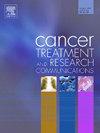Peripheral blood cells as prognostic markers in patients with advanced non-small cell lung cancer treated with cemiplimab as monotherapy or in combination with chemotherapy
IF 2.4
Q3 Medicine
引用次数: 0
Abstract
Background
Patients with a high neutrophil/lymphocyte ratio (NLR) have poor prognosis in non-small cell lung cancer (NSCLC). Limited data are available on the contribution of other immune cells. This analysis assessed the prognostic importance of NLR and other peripheral blood cells in patients with advanced NSCLC receiving the PD-1 inhibitor cemiplimab in 2 large phase III studies.
Methods
The impact of baseline immune cells on survival was assessed in patients with complete blood cell counts. Cox proportional hazard regression and Kaplan–Meier methods assessed the relationships between baseline blood cell counts and survival. Data were randomly split into training (70 %) and validation (30 %) cohorts to allow for independent evaluation of the Cox model.
Results
Multivariable analyses revealed that a higher NLR (HR: 1.09; 95 % CI: 1.06–1.12, P < .001) and monocytes (HR: 1.49; 95 % CI: 1.15–1.93, P < .001) were strongly associated with an increased risk of death. Higher levels of eosinophils (HR: 0.93; 95 % CI: 0.88–0.99, P < .001) were associated with a reduced risk of death. A calibration curve of observed and predicted probabilities in the unseen test set using independent data revealed that the Cox model was well-calibrated up to a 1-year mortality probability of approximately 30 %. Harrell’s concordance index was 0.61, indicating a modest predictive performance.
Conclusions
Our data confirmed the detrimental impact of a high NLR on survival and revealed the importance of monocyte levels in anti-tumor responses, providing useful information to physicians treating advanced NSCLC that may help tailor immunotherapy regimens and provide more accurate prognostic assessments.
外周血细胞作为晚期非小细胞肺癌患者单药治疗或联合化疗的预后标志物
背景:中性粒细胞/淋巴细胞比值(NLR)高的非小细胞肺癌(NSCLC)患者预后较差。关于其他免疫细胞的作用的数据有限。该分析在2个大型III期研究中评估了NLR和其他外周血细胞对接受PD-1抑制剂西米单抗治疗的晚期非小细胞肺癌患者预后的重要性。方法在全血细胞计数患者中评估基线免疫细胞对生存的影响。Cox比例风险回归和Kaplan-Meier方法评估了基线血细胞计数与生存率之间的关系。数据随机分为训练组(70%)和验证组(30%),以便对Cox模型进行独立评估。结果多变量分析结果显示,高NLR (HR: 1.09;95% CI: 1.06-1.12, P <;.001)和单核细胞(HR: 1.49;95% CI: 1.15-1.93, P <;.001)与死亡风险增加密切相关。嗜酸性粒细胞水平升高(HR: 0.93;95% CI: 0.88-0.99, P <;.001)与死亡风险降低相关。使用独立数据的未见测试集中的观测概率和预测概率的校准曲线显示,Cox模型经过良好校准,1年死亡率概率约为30%。Harrell’s concordance index为0.61,表明具有适度的预测性能。结论sour数据证实了高NLR对生存的不利影响,揭示了单核细胞水平在抗肿瘤反应中的重要性,为治疗晚期NSCLC的医生提供了有用的信息,可能有助于定制免疫治疗方案,并提供更准确的预后评估。
本文章由计算机程序翻译,如有差异,请以英文原文为准。
求助全文
约1分钟内获得全文
求助全文
来源期刊

Cancer treatment and research communications
Medicine-Oncology
CiteScore
4.30
自引率
0.00%
发文量
148
审稿时长
56 days
期刊介绍:
Cancer Treatment and Research Communications is an international peer-reviewed publication dedicated to providing comprehensive basic, translational, and clinical oncology research. The journal is devoted to articles on detection, diagnosis, prevention, policy, and treatment of cancer and provides a global forum for the nurturing and development of future generations of oncology scientists. Cancer Treatment and Research Communications publishes comprehensive reviews and original studies describing various aspects of basic through clinical research of all tumor types. The journal also accepts clinical studies in oncology, with an emphasis on prospective early phase clinical trials. Specific areas of interest include basic, translational, and clinical research and mechanistic approaches; cancer biology; molecular carcinogenesis; genetics and genomics; stem cell and developmental biology; immunology; molecular and cellular oncology; systems biology; drug sensitivity and resistance; gene and antisense therapy; pathology, markers, and prognostic indicators; chemoprevention strategies; multimodality therapy; cancer policy; and integration of various approaches. Our mission is to be the premier source of relevant information through promoting excellence in research and facilitating the timely translation of that science to health care and clinical practice.
 求助内容:
求助内容: 应助结果提醒方式:
应助结果提醒方式:


